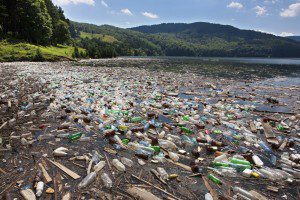Contributing writer for Wake Up World
“EVERY single piece of plastic that has ever been created since the 19th century is still SOMEWHERE on our planet. So if it never goes away, where does it go?” — this is the startling idea behind the eye-opening documentary, Plastic Paradise.
Plastic is difficult to escape. Simply walk through your local supermarket and take in the sheer number of products housed in plastic. We feel we do our part for the planet by recycling. But do we?
According to the documentary, recycling is a bit of a misnomer because only two types of plastic are widely recyclable — and even then, it’s downgraded into other products which cannot be recycled further. It’s a one time deal. The next step for these items is the landfill — or worse, the ocean, where plastic seriously harms wildlife, the ecosystem and eventually, our health.
A disturbing account of how plastic invades our lives
The documentary opens with a shot of dead birds on a plastic-laden beach. The point is graphically driven home that we are in terrible danger of completely destroying the ocean and life within. The beach in question belongs to Midway Atoll, an island halfway between the west coast of the U.S. and the eastern side of Japan. What makes the island special is that a good portion of marine debris (consisting of 90% plastic) accumulates on Midway due to the whirlpool effect of Pacific currents. It’s similar to a canary in the coal mine, alerting us to grave ecological imbalance.
On this single island, adult albatross birds bring in five tons of plastic each year to unwittingly feed to their chicks, believing it to be food. Midway is home to 70% of the world’s Laysan Albatross population and a major breeding ground. Needless to say, the birds are in serious trouble with a high death rate due to their diet of plastic.
Birds aren’t the only animals harmed by the material, all marine life is affected — including the coral reefs, which are destroyed by tumbleweed-like discarded nylon fishing nets that become entangled in the coral, breaking off pieces as the mass is pulled along by the current. Fish, seals, dolphins, whales, sea turtles — you name it and plastic has killed any number. It’s slowly killing us too.
Human casualties
By now, most of us are aware of bisphenol A (BPA) and the devastating effects this plastic additive has on the human endocrine system. It has been linked to a number of disorders, from cancer to diabetes, infertility and obesity. It was developed in 1936 as a form of birth control due to its estrogenic activity, but BPA wasn’t strong enough for the job. As industry can never let a synthetic chemical go to waste, a new purpose for BPA was found by adding it to polycarbonate plastics beginning in the early 1950s. It took nearly sixty years before the dangers of BPA were known to the public. It’s estimated that 93% of Americans have BPA within their bodies.
But plastic also contains DDT and PCB — two extremely toxic chemicals. The health effects of DDT include cancer, male infertility, miscarriages and low birth weight, developmental delay, nervous system and liver damage. PCBs also contribute to cancer and cause disorders of the immune, reproductive, nervous and endocrine systems.
All three toxins leach into the ocean as the plastic breaks down. Fish also eat these irresistible plastic bits and the toxins eventually lodge in their tissues. Invariably, these poisons end up on our dinner plates.
We might ask how we arrived at this point, with plastics such an unavoidable — and dangerous — material in our lives?
History of a modern day ‘miracle’
During World War II, raw materials were in short supply and we needed a resilient, economical and easily manufactured substitute. Plastic to the rescue! Made from readily available petroleum, plastic was the go-to material for the war machine. It was also a boon for oil companies as they had an entirely new market to tap — from 20 million pounds in 1927 to 650 million pounds by 1943. That’s a 3,000% increase in just a few short years. Today, the U.S. is expected to produce a staggering 115 billion pounds this year alone.
Here’s the catch: every piece of plastic that was ever made is still with us today as it was designed to last — and it does, for hundreds of years. The ecosystem and our health are choked by it. What will the planet look like in the not so distant future with the ever increasing influx of this hardwearing material? It’s a sobering thought and one that doesn’t have an easy answer.
Keeping the plastic tide at bay
Although it might appear otherwise, we are not powerless against the rising wave of plastic. But we do need to take responsibility. Below are ideas on how to curb plastic overload:
Watch Plastic Paradise and take action — see trailer below.
Spread the word about the dangers of plastic to family and friends, the community at large and your government officials. Local library screenings of the film are a great way to reach the public. Or hand out reusable grocery bags with a card explaining the dangers of plastic. Ask the recipient to pay it forward by educating others and giving away bags of their own.
Reject single use plastic bags, food containers and bottles.
It’s easy to keep reusable bags for groceries and produce stashed in your purse, pocket or car for shopping trips. Stainless steel or glass water bottles and mugs are also a simple alternative to plastic and styrofoam disposables, as are stainless steel food containers.
Rethink shampoo, dish and laundry soap.
The ideal is to find a store where you can bring your own glass or metal containers to refill with dish and laundry soap, along with shampoo. You can also make your own by using raw materials that come in biodegradable packaging. Not only will you help save the environment and your health, but also hard earned cash too.
Petition your favorite brands to favor biodegradable packaging.
An excellent alternative to petroleum based plastic is hemp plastic. It’s exceptionally strong, versatile and biodegradable. In fact, many automotive companies already utilize hemp plastic panels in their cars because of its strength and durability.
Contact your local stores and educate them about the damaging effects of plastic.
Ask that they adopt a zero waste model like this market in Germany. Alternatively, encourage grocery stores to use biodegradable food packaging and bags.
Avoid synthetic fabrics and opt for hemp, wool, cotton or silk instead.
If you must have that polar fleece jacket (or whatever synthetic fabric it may be), participate in the North Face “Clothes the Loop” up-cycling program when the article of clothing has run its course.
Swap out plastic wrap and bags.
Beeswax coated fabric is a fun and natural plastic alternative. It clings to bowls and dishes and can be folded around sandwiches and the like for portability. My Green Family offers an easy tutorial on how to make your own beeswax and cotton wrap.
Consider your supplements.
If you’re anything like me, you have a good amount of vitamins and herbs squirreled away in your cabinet. Look for brands that aren’t housed in plastic. Udo’s Choice is one company that comes to mind that uses biodegradable glass with metal caps.
Don’t purchase or eat canned food.
While the outer can is generally eco-friendly, the inside is most likely lined with plastic. Many companies have adopted BPA-free liners, which is a step in the right direction, but it’s not enough.
If you have children, choose natural toys.
There’s a great selection of wooden, fabric and cardboard toys available which won’t harm the environment or your child. Better yet, tap into your creativity and create unique playthings from your recyclables. Sites like Pinterest have many wonderful ideas on how to make eco-friendly, waste-free toys.
Lastly, one of the best methods for reducing plastic consumption is to be mindful that plastic never really disappears and creates tremendous damage to ourselves and the environement. Voting with our dollars and avoiding plastic products sends a strong message to industry that we won’t tolerate the trashing of the planet, wildlife or our health.
Plastic Paradise: The Great Pacific Garbage Patch
Plastic Paradise: The Great Pacific Garbage Patch Trailer from Angela Sun on Vimeo.
Article sources:
- http://plasticparadisemovie.com
- http://www.ehhi.org/reports/plastics/bpa_health_effects.shtml
- http://www.panna.org/issues/persistent-poisons/the-ddt-story
- http://www.epa.gov/wastes/hazard/tsd/pcbs/pubs/effects.htm
- http://hempwaterbottles.tripod.com/what-is-hemp-plastic.html
- http://begreenpackagingstore.com
- http://myhealthygreenfamily.com/blog/wordpress/plastic-wrap-alternative…/
Previous articles by Carolanne:
- The Greenhouse of the Future — Grow Your Own Food Year-Round With This Revolutionary System
- First U.S. City Produces More Electricity Than It Uses — With 100% Renewable Technology
- Dry Skin Brushing Can Strengthen Immunity, Spark Detoxification and Reverse Aging
- Cannabis Dissolves Cancerous Tumor in Young Infant, Deemed ‘Miracle Baby’ by Physician
- Report Finds Cancer Deaths Have Doubled in Argentina’s GMO Growing Regions
- Is Mold Making You Sick?
- Why Everyone Should be Eating More Hempseed
- Autistic Boy with Higher IQ Than Einstein Discovers Gift After Removal from State-Run Therapy
- Enhance Spiritual, Mental and Physical Well-being with a Pineal Gland Detox
- DIY $2 Self-Watering Garden Bed – Grow Produce Easily, Even in the Toughest Conditions
- How Being Too Clean Can Lead to Cancer, Multiple Sclerosis, Celiac Disease and More
About the author:
I’m Carolanne — a writer, chef, traveler and enthusiastic advocate for sustainability, organics and joyful living. It’s good to have you here. If you would like to learn more, connect with me at Thrive-Living.net or visit Twitter.com/Thrive_Living.
If you've ever found value in our articles, we'd greatly appreciate your support by purchasing Mindful Meditation Techniques for Kids - A Practical Guide for Adults to Empower Kids with the Gift of Inner Peace and Resilience for Life.
In the spirit of mindfulness, we encourage you to choose the paperback version. Delve into its pages away from screen glare and notifications, allowing yourself to fully immerse in the transformative practices within. The physical book enriches the learning process and serves as a tangible commitment to mindfulness, easily shared among family and friends.
Over the past few years, Wake Up World has faced significant online censorship, impacting our financial ability to stay online. Instead of soliciting donations, we're exploring win-win solutions with our readers to remain financially viable. Moving into book publishing, we hope to secure ongoing funds to continue our mission. With over 8,500 articles published in the past 13 years, we are committed to keeping our content free and accessible to everyone, without resorting to a paywall.









